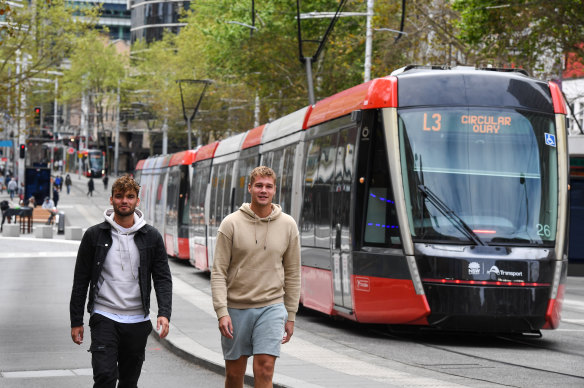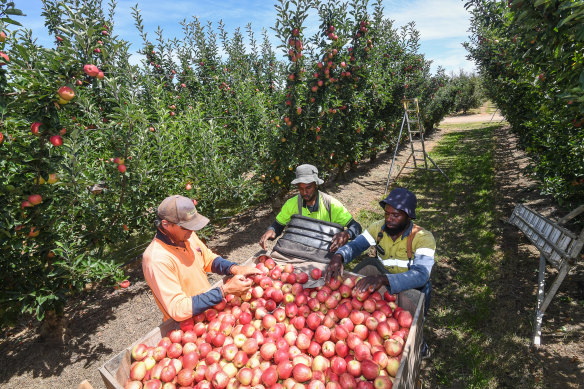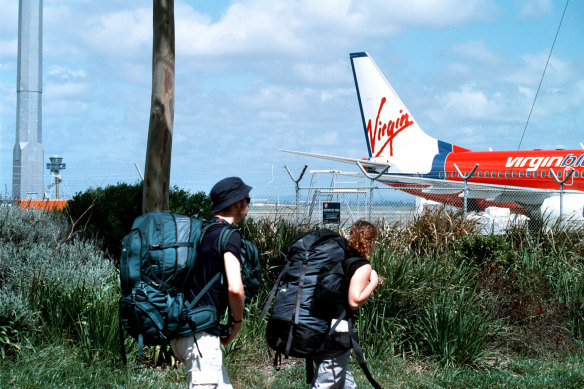Two years after COVID exodus, backpackers are back but many more needed

More than two years after they were locked out of Australia, backpackers are finally coming back – but not quickly enough for peak industry groups desperate for workers.
About 6000 backpackers a month have been arriving in Australia since the border reopened at the end of February, meaning it could take years to rebuild the workforce to what it was before COVID-19.
Newly arrived backpackers Dani van Steijn and Bob Visser hope to work and travel around Australia.Credit:Peter Rae
Experts say the high cost of airfares, competition from other countries and fears that Australia will reclose its borders are turning some backpackers off travelling to Australia and taking up essential jobs in industries, such as agriculture and hospitality. About 56,000 are now in Australia.
“We still need so many more,” Restaurant and Hospitality Industry Association chief executive Belinda Clarke said. “We’re missing over 100,000 workers in hospitality and a huge proportion of those roles are taken up by backpackers in seasonal areas.”
Agriculture, which relies on backpackers for harvesting crops, is facing a similar problem, with an estimated 172,000 jobs vacant across the food supply chain, which includes hospitality.
“We’re just not seeing them,” Barooga persimmon farmer and NSW Farmers workplace relations spokesman Chris Stillard said. His neighbours had told him “their biggest concern with the harvest this year is getting workers to pick their crop”.
The housing crisis in regional Australia was also making it difficult for farmers to attract workers, he said, and some farmers have banded together to buy pubs or disused convents to turn them into accommodation for workers.
National Farmers Federation chief executive Tony Mahar said the worker crisis in agriculture was pushing up the price of food.
“When COVID saw the mass exodus of workers, the labour crisis worsened and farmers were forced to scale back production, and watch their crops rot in the paddock. We know these production impacts are continuing now as we continue to go without visiting workers.”
The Pacific Australia Labour Mobility scheme, which began in April, had partly filled the void, he said, but it wasn’t enough and Australia needed more visa pathways for agricultural workers.
Farms cannot find enough workers to harvest crops.Credit:Justin McManus
Dutch backpacker Dani van Steijn, who arrived in Sydney with a friend on Tuesday, said the pair decided to come to Australia after hearing the borders had reopened and were hoping to find jobs that came with accommodation. They intended to do 88 days of farm work at some point to meet the requirements for a second 12-month visa.
“The only plan we have is work in Sydney for a month, then go to Melbourne and do the same thing – to go to every big city, and along the coast, and work.
“Australia always attracted me, it’s the kind of country I wanted to visit. Especially now it’s open after COVID, it will be a nice experience to work here and explore it some more.”
He said he was granted his visa immediately after applying, and other backpackers had recounted the same experience.
The high cost of airfares may be turning backpackers off a trip to Australia.Credit:Tanya Lake
At the Regional Australia Institute Summit in Canberra on Tuesday, Home Affairs Assistant Secretary Karin Maier said the department was working quickly through Australia’s visa application backlog, and had cleared 1.7 million applications for various visas between June and September.
A government spokesperson said Australia remained attractive to backpackers and half of all working holiday visas were now finalised in less than a day.
During COVID-19, after the federal government closed the borders and denied temporary visa holders access to financial support such as JobKeeper, the number of working holiday visa holders in Australia fell from about 140,000 to just over 19,000. Another 9854 working holidaymakers were granted a special COVID-19 pandemic visa to allow them to stay and work in Australia, and there are also 5750 such visa applications pending.
Griffith University research fellow Kaya Barry, who has received an Australian Research Council Grant to study the future of backpacking and seasonal farm work in Australia, said the cost of airfares, as well as a fear of border closures, may be stopping more backpackers from flying to Australia.
“I’ve interviewed 10 backpackers this year who are back here and most of them were saying they were hesitant to come to Australia because of the threat that, if the border closures, they’ll be stuck.
“Hostels are saying similar things. They’re getting emails or calls from people overseas, asking, ‘Can you help us book a fight home if the borders shut again?’
“That image of Australia as a fortress … has scared a lot of people, particularly younger people. And the fact [backpackers] received no government support during lockdowns and restrictions … that was a really poor decision, given they are such a critical workforce.”
Figures from the Department of Home Affairs show almost 100,000 people were granted a working holiday visa in the first six months of this year, suggesting tens of thousands are yet to make the trip to Australia, although some may have come and already left.
Barry said visa holders often delayed their trip to Australia to allow them to finish university or a work contract, or would take an extended journey through other countries, with Australia the final destination.
The Morning Edition newsletter is our guide to the day’s most important and interesting stories, analysis and insights. Sign up here.
Most Viewed in National
From our partners
Source: Read Full Article



